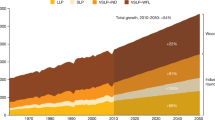Abstract
A carbon budget model was developed to examine the effects of forest management practices on carbon storage in U.S. private timberlands. The model explicitly incorporates the demand for wood products and its impact on harvesting and other management decisions. Forest carbon is divided into four components: carbon stored in trees, soils, forest litter, and understory vegetation. Changes in the forest carbon inventory result from tree growth and management activities, in particular harvesting. Harvesting of timber for wood products is determined by demand and supply forces. The model then tracks carbon in timber removals through primary and secondary processing and disposal stages. Harvesting also has effects on carbon in soils, forest litter, and understory vegetation. A base-run scenario projects increases in carbon storage in U.S. private timberlands by 2040; however, this increase is offset by carbon emissions resulting from harvesting.
Similar content being viewed by others
References
Adams, D. M., Haynes, R. W.: 1980, ‘The 1980 Softwood Timber Assessment Model: Structure, Projections, and Policy Simulations’,Forest Science 26, Monograph 22, 64 pp.
Alig, R. J., Hohenstein, W. G., Murray, B. C., and Haight, R. G.: 1990, ‘Changes in Area of Timberland in the United States, 1952–2040, By Ownership, Forest Type, Region, and State’, General Technical Report SE-64, USDA Forest Service, Southeastern Forest Experiment Station, Asheville, North Carolina, 34 pp.
Birdsey, R. A.: 1991, ‘Impacts of U.S. Forest Management Policies on the Carbon Cycle’, inAgriculture in a World of Change, Proceedings of Outlook '91, 67th Annual Outlook Conference, U.S. Department of Agriculture, Washington, D.C., pp. 348–359.
Detwiler, R. P., Hall, C. A. S.: 1988, ‘Tropical Forests and the Global Carbon Cycle’,Science 239, 42–47.
Economic Commission for Europe and Food and Agriculture Organization: 1986, ‘European Timber Trends and Prospects to the Year 2000 and Beyond’, ECE/TIM/30, Geneva, 2 volumes.
Economic Commission for Europe and Food and Agriculture Organization: 1989, ‘Outlook for the Forest and Forest Products Sector of the USSR’, ECE/TIM/48, Geneva, 105 pp.
Forestry Canada: 1991, ‘The State of Forestry in Canada: 1990 Report to the Parliament’, Catalogue No. Fol-6/1991E, Ottawa, 80 pp.
Harmon, M. E., Ferrell, W. K., and Franklin, J. F.: 1990, ‘Effects on Carbon Storage of Conversion of Old-Growth Forests to Young Forests’,Science 247, 699–702.
Haynes, R. W., Adams, D. M.: 1985, ‘Simulations of the Effect of Alternative Assumptions of Demand-Supply Determinants on the Timber Situation in the United States’, USDA Forest Service, Forest Resources Economics Research, Washington, D.C., 113 pp.
Houghton, R. A., Boone, R. D., Fruci, J. R., Hobbie, J. E., Melillo, J. M., Palm, C. A., Peterson, B. J., Shaver, G. R., Woodwell, G. M.: 1987, ‘The Flux of Carbon from Terrestrial Ecosystems to the Atmosphere in 1980 Due to Changes in Land Use: Geographic Distribution of the Global Flux’,Tellus 39B, 122–139.
Mills, J. R. and Kincaid, J. C.: 1991, ‘The Aggregate Timberland Assessment Sytem - ATLAS: A Comprehensive Timber Projection Model’, General Technical Report, USDA Forest Service, Pacific Northwest Research Station, Portland, Oregon (in press).
Row, C. and Phelps, R. B.: 1991, ‘Carbon Cycle Impacts of Future Forest Products Utilization and Recycling Trends’, inAgriculture in a World of Change, Proceedings of Outlook '91, 67th Annual Outlook Conference, U.S. Department of Agriculture, Washington, D.C., pp. 360–369.
Tans, P. P., Fung, I. Y., and Takahashi, T.: 1990, ‘Observational Constraints on the Global Atmospheric CO2 Budget’,Science 247, 1431–1438.
United States Department of Agriculture, Forest Service: 1990, ‘An Analysis of the Timber Situation in the United States: 1989–2040, General Technical Report RM-199, Rocky Mountain Forest and Range Experiment Station, Fort Collins, Colorado, 268 pp.
Waddell, K. L., Oswald, D. D., and Powell, D. S.: 1989, ‘Forest Statistics of the United States, 1987’, Resource Bulletin PNW-RB-168, USDA Forest Service, Pacific Northwest Research Station, Portland, Oregon, 106 pp.
World Resources Institute: 1990,World Resources: 1990–1991, Oxford University Press, Oxford, pp. 292–293.
Author information
Authors and Affiliations
Rights and permissions
About this article
Cite this article
Plantinga, A.J., Birdsey, R.A. Carbon fluxes resulting from U.S. private timberland management. Climatic Change 23, 37–53 (1993). https://doi.org/10.1007/BF01092680
Received:
Revised:
Issue Date:
DOI: https://doi.org/10.1007/BF01092680




